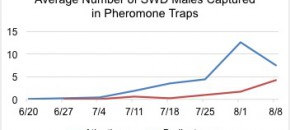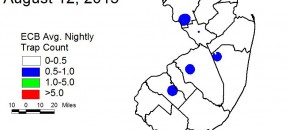Late blight has been found in a small tomato planting near Layton in Sussex County. This is the second report this growing season in New Jersey and the first since early July. All tomato growers should scout their fields on a regular basis. The incoming hot, dry weather should help reduce any potential threat from […]
Continue reading...Fruit IPM Report 8-13-2015

Peach Oriental Fruit Moth (OFM): The third flight and all required treatment timings are now over throughout the state. Additional treatments will only be required on very late varieties, and only if trap counts exceed 6 moths per trap. Tufted Apple Budmoth (TABM): We are in the middle of the second flight, but pest pressure […]
Continue reading...Potato | Tomato Disease Forecast 8-13-15
Click to View | Download Report 8-13-15 Potato Disease Forecasting Report We will be tracking DSVs for Late blight development and calculating P-days for initiating the first early blight fungicide application. The first late blight fungicide application is recommended once 18 DSVs accumulate from green row. Green row typically occurs around the first week in May […]
Continue reading...Veg IPM Update: Week Ending 8/12/15

Sweet Corn European corn borer (ECB) adult activity is on the increase, with low catches in parts of the state now. The second adult flight is underway. Areas of highest activity are scattered throughout the state with one notable hot spot in central Morris County (see ECB map). As always, consider treating when the number […]
Continue reading...Two Important Vegetable Production Pathogens Confirmed in NJ
Dickeya sp., an aggressive form of Black leg, has been confirmed on potato in New Jersey. Symptoms of Dickeya infection look similar to Black leg infection and can cause significant rot above ground (stems and foliage) and below ground (tubers). Very little information is available on Dickeya, since it is most likely a new pathogen […]
Continue reading...Vegetable Disease Briefs – 8/11/15
Bacterial leaf spot race 6 has been confirmed on bell pepper in the Vineland area. This has major implications since all widely-grown peppers (bell and non-bell) in New Jersey do not have resistance to this race. All bell peppers growers need to scout on a regular basis and know what BLS resistance packages are present in the varieties they are growing. […]
Continue reading...